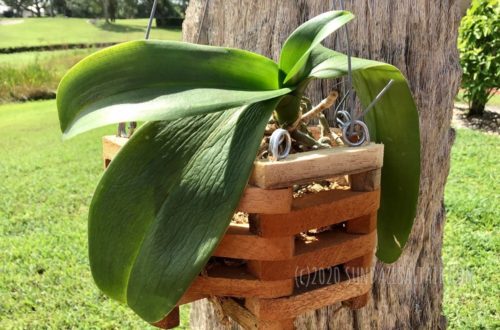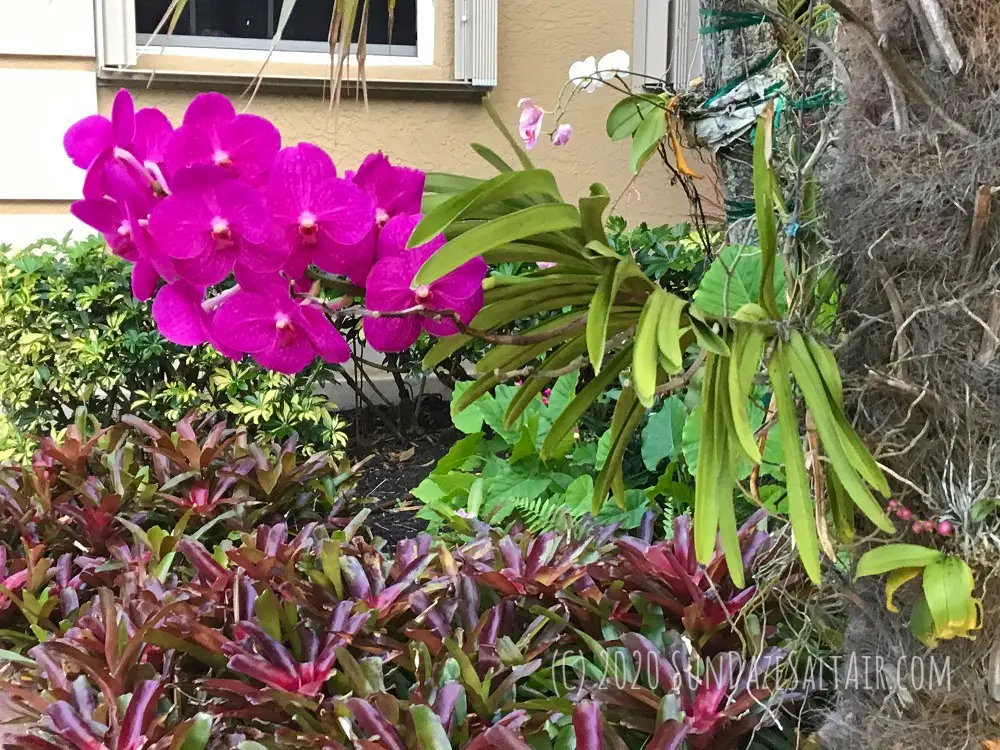
How To Mount Or Attach Your Vanda Orchid To A Tree & Why You Should Grow Orchids On Trees
How To Grow Your Vanda Orchids On Trees: A Step-By-Step Guide To Mounting & Cultivating Them
I have quite a few posts dedicated to the care and cultivation of the incomparable orchid, but even among this amazing and diverse family of plants, vanda orchids are in a class by themselves. Vandas are renowned for their notably tall and stunning spray of flowers that are quite unique in the plant world. Plus, vanda’s flowers are long-lasting with blooms that come in a rainbow of rare and vibrant colors, sometimes accompanied by a sweet-smelling fragrance. All of these unique characteristics certainly earn vanda its place as a pre-eminent symbol of exotic, tropical beauty the world over.
Let’s take a closer look at how some of vanda’s particular attributes, including its love for heat, ventilation and humidity, also make the epiphytic vanda the ideal orchid for growing on trees — in the right warm climate. Plus, I’ll explain how you, too, can easily mount and grow your own captivating vanda on a tree.
To skip straight to the instructions on how to mount your vanda, scroll down to, “Step-By-Step Instructions to Attach & Grow Your Vanda Orchids on Trees.”
Find out how to water & fertilize your vanda orchid for maximum blooming potential in this post.
Disclosure: This post contains some affiliate links for recommended products for which a small commission may be earned if you choose to make a purchase through a link. This is at no additional cost to you.
Reason #1 To Mount & Grow Your Vanda Orchids on Trees? Replicate The Ventilation A Vanda Craves & Receives Growing Wild
Like most tropical orchids, vandas are epiphytes. This means vandas grow soil-less, attaching themselves to trees, rocks, or other objects, thanks to their extremely efficient air roots which absorb moisture and nutrients just from their surroundings alone. Therefore, the last thing you want to do is attempt to pot your vanda and its abundant roots. Instead, provide your vanda with the airier treatment it craves by simulating the conditions it enjoys growing freely in the wild.
One way to do this is to mount your vandas on trees similar to how they grow in their natural habitat. There, in the fresh, open air of the sultry, sun-dappled rainforest, vandas grow attached or suspended from bark and branches. In this dynamic environment, vanda’s highly adaptive roots are free to take advantage of all the nutrients and moisture they need from the air and organic surfaces around them.
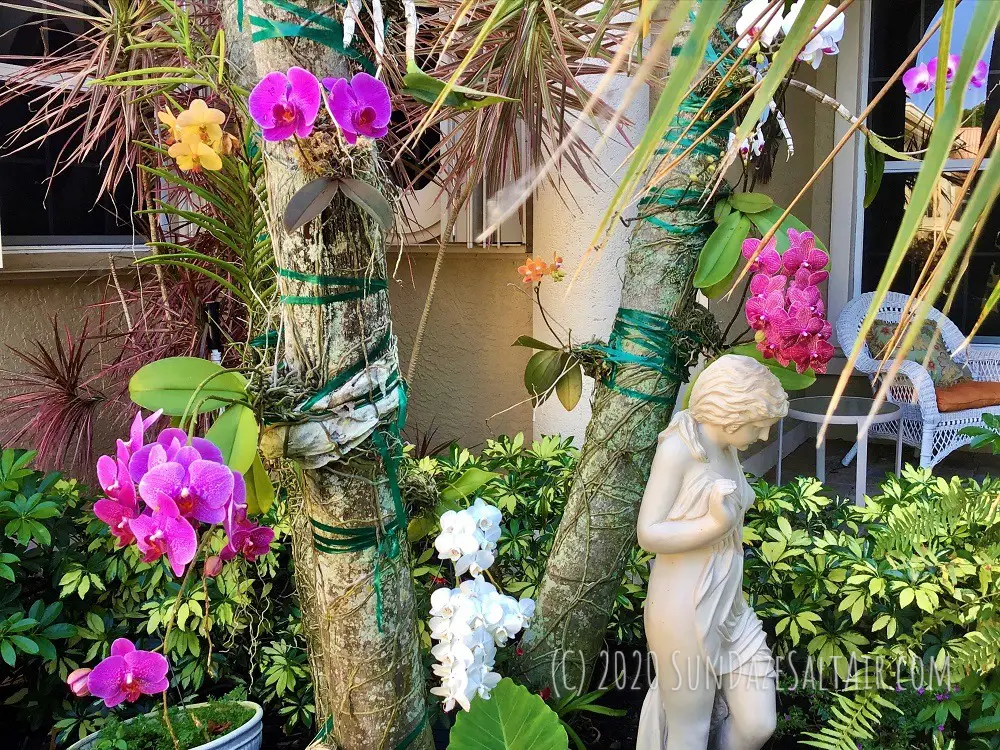
Reason # 2 To Mount & Grow Your Vanda Orchids on Trees? Replicate The Light & Heat Vandas Love
By attaching themselves to trees in their rainforest habitat, it’s easy to see how epiphytic vandas truly have the best of all worlds. Suspending themselves from trees provides vandas with access to more sunlight than they would have growing on the forest floor. At the same time, vandas are shielded from the harshness of direct sunlight by the rainforest canopy.
While orchids originate in a variety of diverse habitats, the vanda is primarily native to the steamy, warm tropical and sub-tropical rainforests of Southeast Asia, stretching from the islands of New Guinea up through the rainforests of India, Vietnam and China. Owing to their tropical roots, this group of orchids is known for being particularly sun and heat loving. As a result, vandaceous orchids generally require a good amount of sunlight, especially in the morning before it gets too hot, so keep this mind when choosing a location to grow your vanda.
However, not all vandas desire the same intensity of sun. Read on to determine which of the three types of vanda you have in order to provide your particular vanda with exactly the right amount of sunlight for its type.
How Much Sunlight Does My Vanda Orchid Need?
The Three Types of Vandas: Determine Your Vanda Type to Determine the Amount of Sun (& Water) It Needs
Vanda’s sun-loving ways have some important caveats that you should observe. First, identify your type of vanda:
- Strap-leaf vandas, as pictured in the top photo on this page, are characterized by broad, flat, egg-shaped leaves, and are less sun-tolerant, so should be shielded from direct sunlight. Provide strap-leaf vandas this protection by growing them in a spot that is shadier in the afternoon to avoid harsh mid-day sun exposure. In addition to requiring more protection from the intense mid-day sun, your strap-leaf vandas will also likely need more frequent watering.
- On the other hand, terete vandas, as seen in the picture directly below, are identifiable by their more thin, cylindrical, and stiff yet slightly fleshy leaves. Terete vandas are more sunlight-tolerant and can be grown in sunnier tropical spots, provided they are in a location with high humidity and ample water or rainfall.
- Semi-terete vandas are a hybrid of strap-leaf and terete vandas and require water and light conditions somewhere between the two described above.
TIP! Make sure any change or increase in sunlight happens gradually to allow your vanda a chance to acclimate to it.
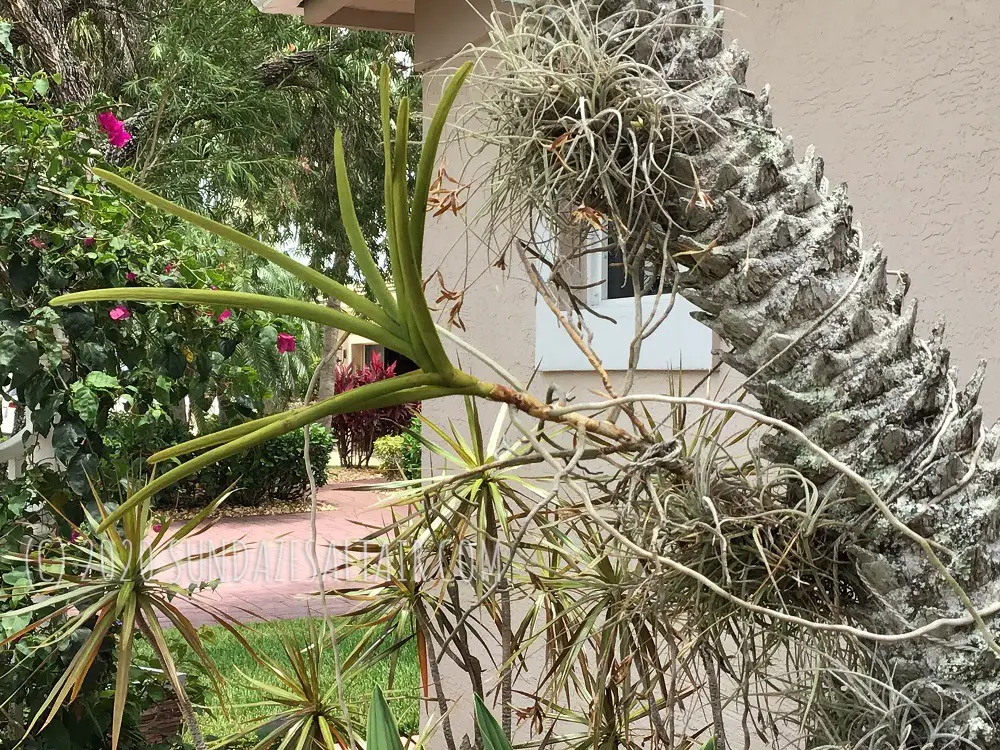
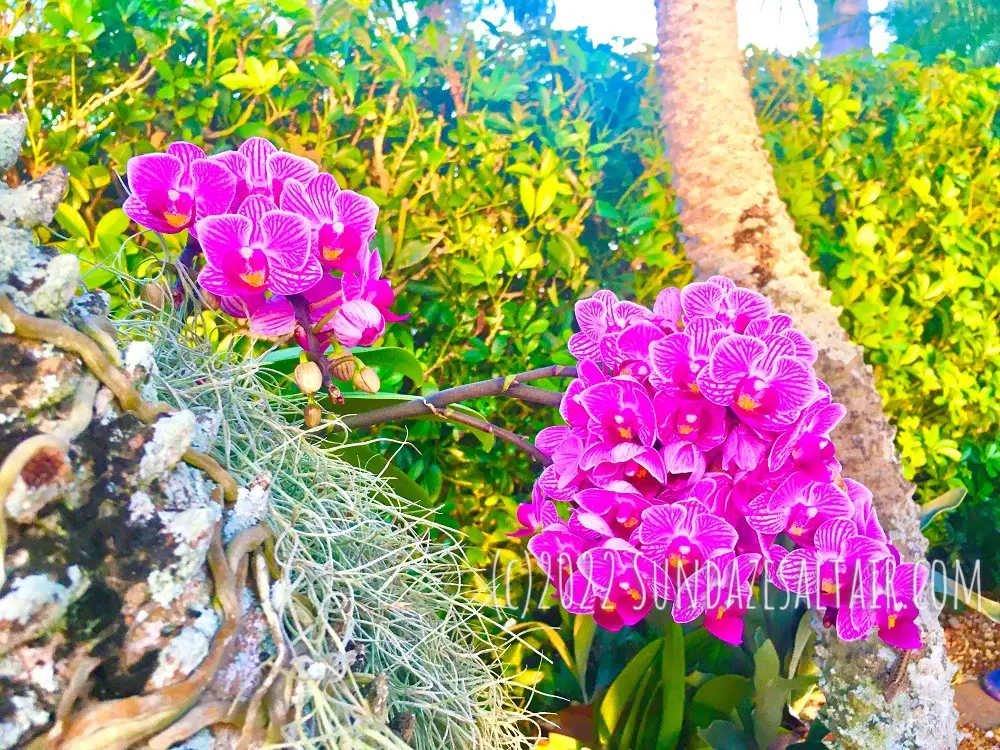
What Temperatures Are Best for My Vanda?
Ensure Your Climate Provides the Warm Temperatures Your Vanda Loves
With vandas being primarily of tropical origin, it comes as no surprise that vandas like it, well, maybe not exactly hot, but definitely very warm and yes, tropical. Even temperatures up to the mid-90’s Fahrenheit (35 degrees Celsius) are tolerable for vanda so long as you follow the vanda mantra: the hotter it is, the more water vanda needs. Warmer temperatures and high humidity promote vanda growth, so just like us, the more heat vandas are subjected to, the more water they will require.
For more specific geographical information on growing vandas on trees, scroll down to “Where Can You Grow Vanda Orchids on Trees in the United States?”
TIP!: To keep your vanda healthy in the heat, always make sure you balance increasing temperatures with increased humidity, increased water, and plenty of ventilation.
Protect Your Vanda Orchid from the Cold
It goes without saying that since vanda’s optimum growth occurs during warm, balmy temps, vandas do not enjoy locations where temperatures fall below 55° F (13° Celsius). Further, ensure that nighttime temperatures do not routinely fall below the 60 and 70° F range, and that vanda is not exposed to temperatures that drop below 55° F for any length of time. Read more about how your orchids can survive the cold, and one thing to never to combine with orchids and cold weather, here. If temperatures do drop, make sure to provide some protection for your vanda from the cold.
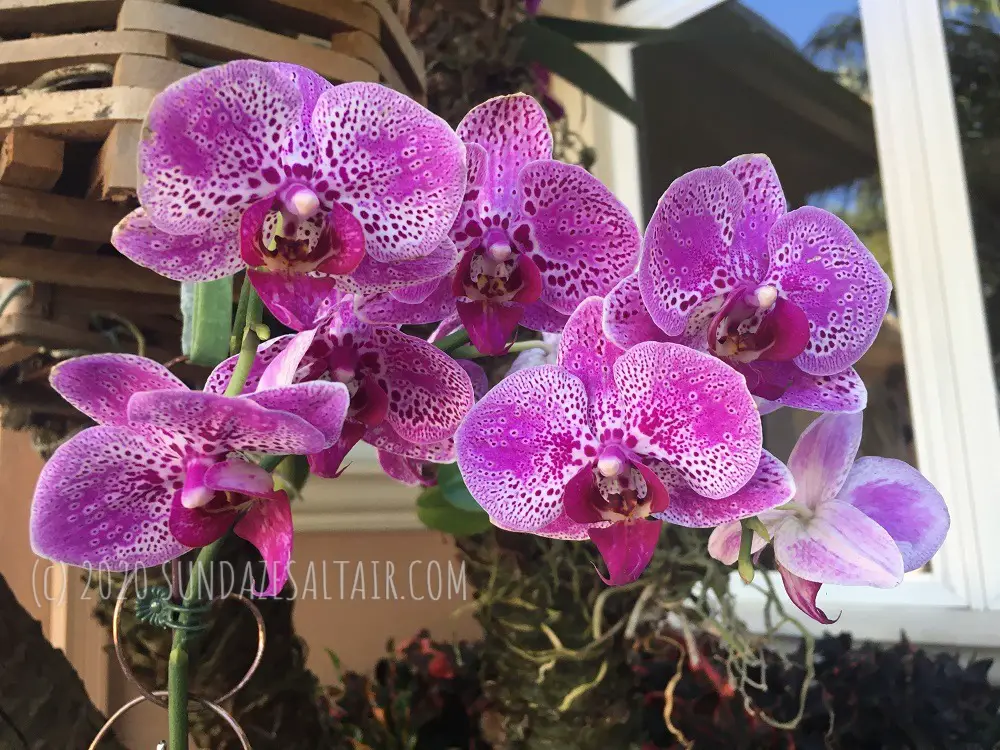

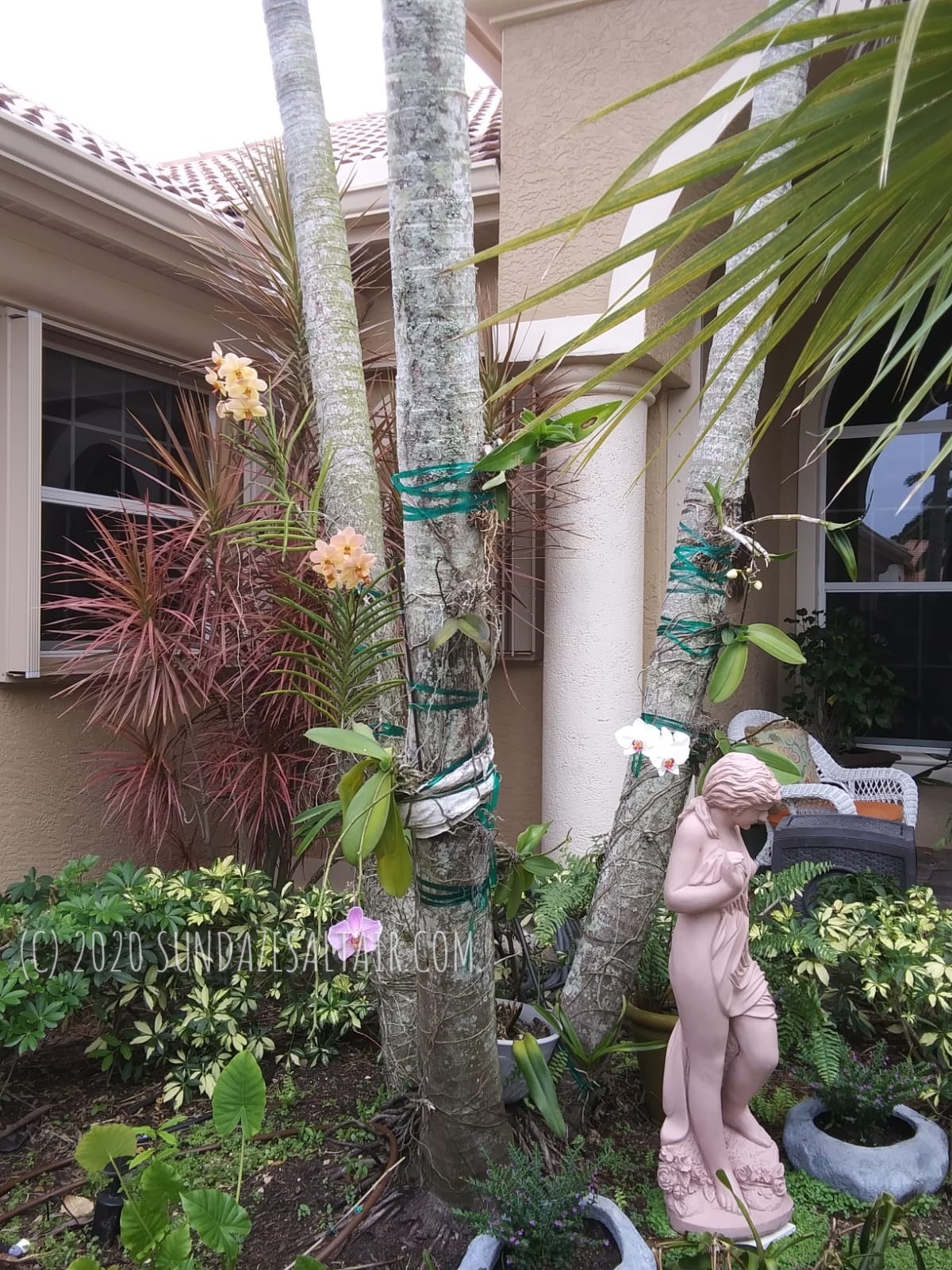
********
Reason #3 To Mount & Grow Your Vanda Orchids on Trees? Replicate The Humidity That Vandas Crave
Considering their Southeast Asian tropical rainforest origins, it comes as no surprise that vanda orchids are fond of humidity. High humidity, somewhere in the 60 to 80 % range is what vandas crave, especially during their peak growing season from early spring through fall. If you reside in a tropical or semi-tropical location, growing your vandas outdoors on trees or in hanging orchid baskets allows you to easily take advantage of the humid, balmy weather, much to your vanda’s delight. In hot summer months, vandas will appreciate it if you augment their watering routine with a daily misting of their air roots using a simple mister or hose on a gentle spray setting.
If growing your vanda indoors, in addition to misting your vanda’s roots, a humidity tray may also be a necessary investment to make your vanda feel at home and to promote growth and flowering.
********
Reason #4 To Mount & Grow Your Vanda Orchids on Trees? Easily Indulge Your Vanda’s Water Needs
Similar to vanda’s need for higher humidity as the temperatures rise, the general rule for watering vanda is, the hotter it gets, the more water your vanda should get.
Adjust Your Vanda’s Watering Schedule Depending on the Season
Especially from early spring until fall, when vanda is in its growing phase, and when days are especially hot and sunny, frequent, daily (or even twice daily) watering is highly recommended. Where I live in the tropics for example, I find hot summers sometimes call for twice daily watering of vandas depending on how much sun they receive.
If you also live in a warm tropical climate, during the dog days of summer, aim to water your vanda for about ten minutes in the morning. In the early afternoon, if your plant’s roots look especially dry, you can give your vanda another quick spray to hydrate its roots.
As we head into the winter season and the sun gets weaker and the weather cooler, it is then advisable to cut back on daily watering. With cooler temperatures, you may reduce your vanda watering schedule to once every two to three days.

********
Where Can You Grow Vanda Orchids on Trees in the United States?
Vandas can be mounted and cultivated on trees in places that include Hawaii and South Florida from the Florida Keys up through Vero Beach on the east coast and Sarasota/Tampa on the west coast. Type in your zip code to find out your growing zone here…
Do you live in zone 10a, 10b or 11? Lucky you! However, while you may have the temperatures to grow vandas in the continental United States in USDA growing zones 10a, 10b and 11, vanda’s high moisture requirements will be very tough to meet in drier locales without conscious, consistent effort in your part. Of course, vandas will thrive outdoors in the Caribbean and in other humid tropical and sub-tropical climates.
In California, orchids can be cultivated along the coastline north to Santa Barbara, and maybe even further north in some warmer, humid coastal micro-climates, as long as protection is provided from the cold during winter.
Other Than Mounted to Trees, What Other Options Are There for Growing Vandas?
Because of vandas extensive root system and monopodial, upward growth pattern that causes the plant to gain height as it grows, growing vandas in hanging baskets is the next best option, and far preferable to pots. Try growing your vandas in baskets hanging on your own vanda trellis, for a unique, one-of-a-kind garden like no other…
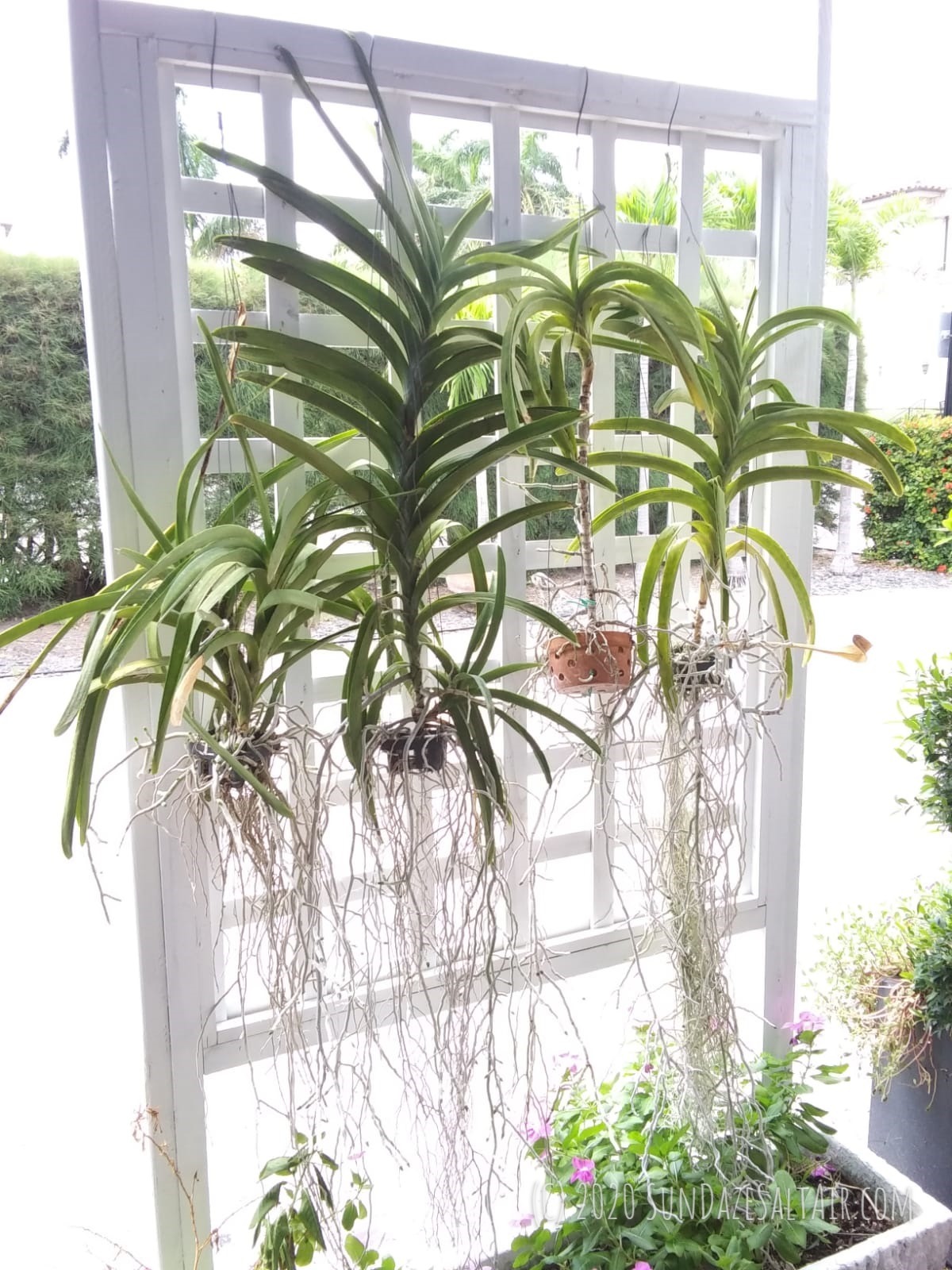
Hanging slotted orchid baskets allow for plenty of ventilation for vanda’s copious roots, while also being relatively low maintenance, requiring infrequent repotting compared to orchids grown in pots.
When Do Vandas Bloom?
In the right conditions, vandas can bloom year-round but their peak blooming season coincides with their peak growing season, between spring and fall.
**Create a “Secret Garden” in your yard by choosing the right arbor depending on where you live here…

********
Step-By-Step Instructions to Attach & Grow Your Vanda Orchids on Trees
Evaluate Your Garden or Yard for the Right Conditions & Choose A Tree
- Observe and evaluate your yard for the right warm, sunny location for your type of vanda as described above.
- Choose a tree. Consider a tree that allows you to prominently display your vanda so you, and others, can view it from a window or from the street. Another very important consideration is choosing a tree that receives adequate light for your type of vanda. Remember thin, cylindrical terete vandas are more tolerant of direct sunlight and can handle a sunnier spot better than the other two types of vandas, strap-leaf and semi-terete.
TIP! What Type of Trees Are Best for Mounting Your Vanda Orchid?
Citrus trees, oaks, cypress, buttonwood and palm trees receive adequate light and don’t cast too much shade so they make great choices for attaching your orchids. If you have them, Robellini palms in particular are great for orchid-mounting with their porous, textured bark which soaks up just the right amount of water. Avoid trees with peeling bark or sappy trees like black olive. While rougher bark is beneficial, the texture of bark is not a total deal breaker as you should be able to grow your orchids on both rough and smooth bark. For tips on which side of the tree is best to attach your vanda, scroll down to “On Which Side of the Tree Should You Attach Your Orchid?” below.
When To Mount or Attach Your Vanda & Preparing Your Orchid to Mount to a Tree
- You can attach your vanda almost any time of the year in your warm climate but try to do so before or after a blooming period. As a result, any adjustment period your orchid goes through after mounting will not affect its flowers.
- Carefully clean your vanda of any potting medium if it was potted, an undesirable condition for these air and ventilation loving orchids. Next, soak your vanda’s roots in water and notice that any dry, silvery roots should turn a lovely shade of green following a good soaking if they are healthy.
Placement Of Your Vanda Orchid on a Tree – Important!
- Once you have selected your chosen location and prepared your vanda by soaking its roots, place your vanda with its leaves at an angle away from the face of the tree on which you want it to attach itself. Doing this allows your vanda to grow towards the sun while allowing its roots to more easily attach themselves to the tree as they grow. It is important for your vanda’s long-term health and growth, as well as blooming, that its roots are able to attach themselves. So, be sure to orient your orchid at an angle so any new leaf growth is pointing away from the trunk.
- You may take a small amount of damp long-form coconut coir and place it, covering like a cup, over one side of the vanda’s roots, but your vanda’s roots should be able to wrap themselves around the tree to attach themselves over time. Find out why certain types of recommended mosses for orchids are not desirable even for moisture-loving vandas here.
- Cut enough of your cotton, biodegradable twine or standard green gardening tape to wrap around the base of your vanda and the tree.
- Wrap your twine, string or tape around a bare spot at the base of your angled vanda and the tree trunk once, not too tight, just so the stem and some of the roots are cozy up against your tree. You may then wrap it around a second time. Tie your twine or tape, again not too tight, as you want your orchid to have some breathing room in case of tree growth. Aim for comfortably, loosely snug.
- If your vanda is large and doesn’t sit well after attaching it, you may need to use another piece of twine or tape so your vanda lays securely against the tree.
Now that your orchid is mounted against its tree, with proper care and maintenance, it is only a matter of weeks or months before you will see your vanda’s roots begin to attach themselves to the tree. Enjoy your vanda’s journey as it attaches itself to its tree, and in no time, your vanda should surprise you with some breathtakingly beautiful blooming!
TIP! On Which Side of the Tree Should You Attach Your Orchid?
While there is a lot of conflicting advice on which side of the tree is best to attach your orchid, according to Jason Downing, an orchid biologist at Fairchild Tropical Botanic Garden, “Look for the lichen.” Lichen, a growth on healthy trees, may appear as small, fleshy clumps or like flat paint. Bottom-line is that lichen signifies a good micro-climate for orchids as lichen are indicative of a surface that gets sufficient sunlight, moisture and minerals to sustain it. Which happen to all be things that are vital to the growth of a healthy and blooming orchid.

********
Can you grow your vandas on trees where you live? Share your best tips for growing vandas on trees in the comments.


You May Also Like
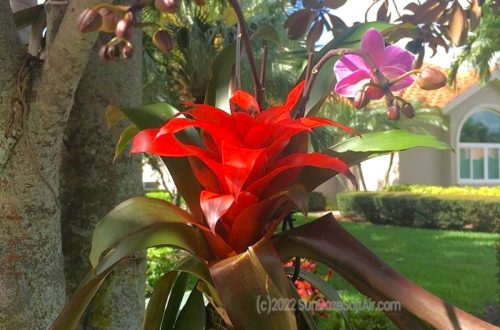
How to Make A Bromeliad Kokedama Hanging Moss Ball for A Beautiful Vertical Garden
March 18, 2022
How To Make A Tropical Wreath
April 30, 2021